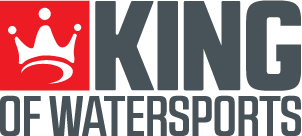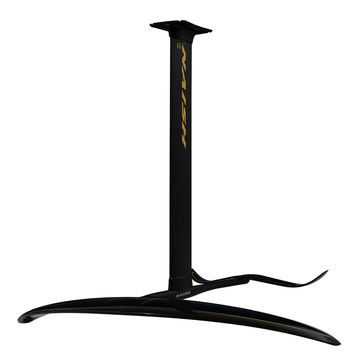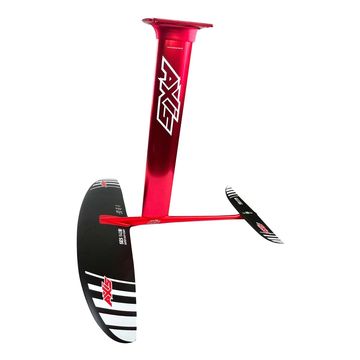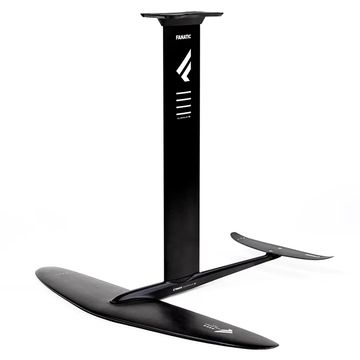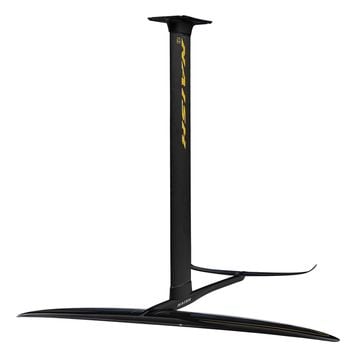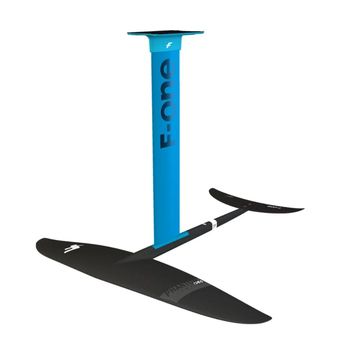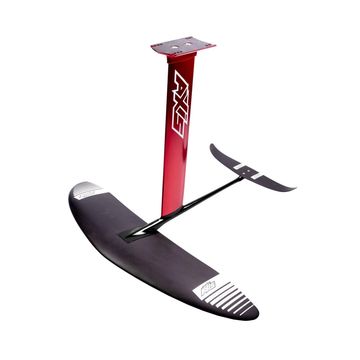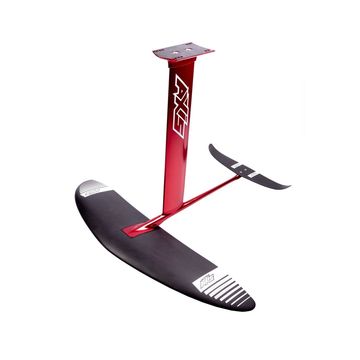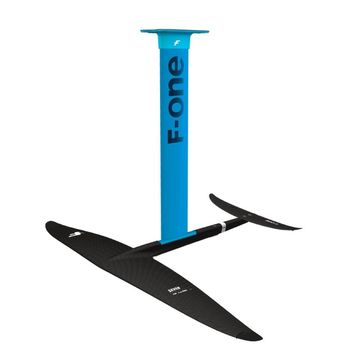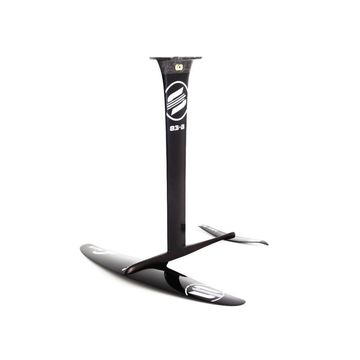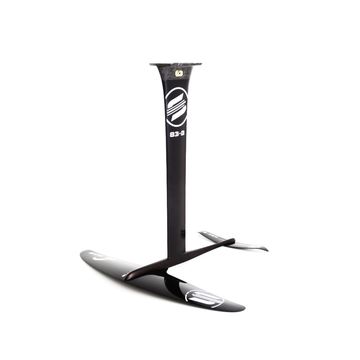A GUIDE TO FRONT WING SIZE AND SHAPE
The world of hydrofoils has grown and got more complicated. Read our guide to getting your head round all the size and types of foil and get to know what will suit you and your style of riding.
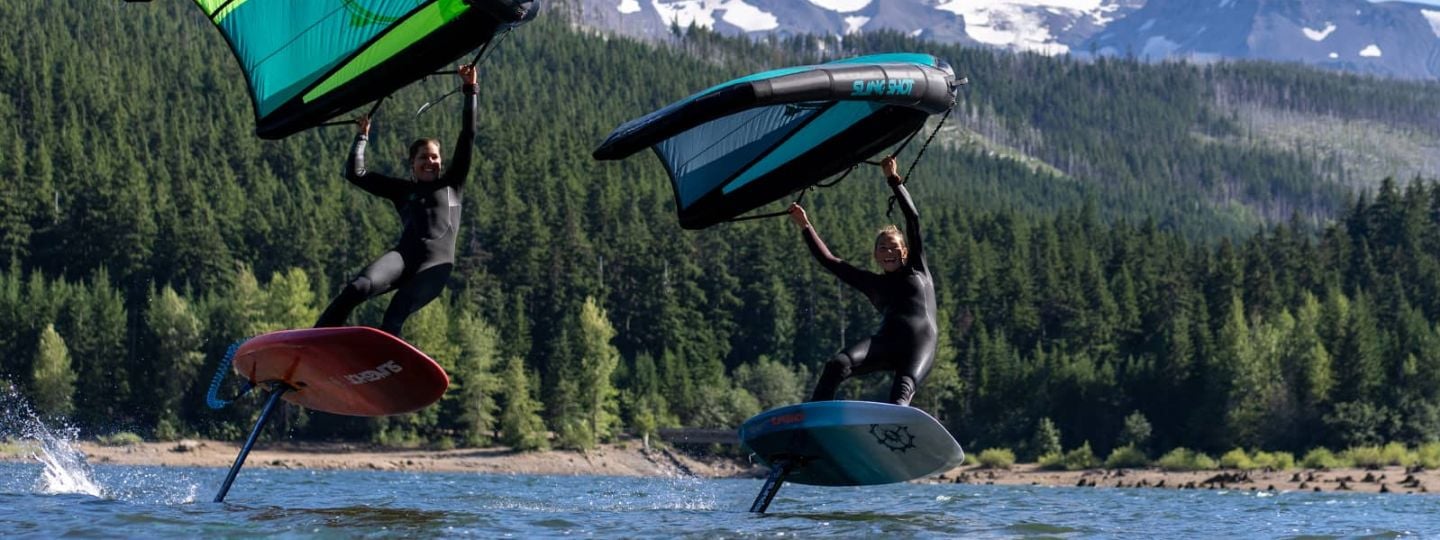
Content created by King of Watersports KOW Copyright
HYDROFOIL SHAPES
With all the foiling sports technology has changed and foils have developed. We have seen trends and now every brand has at least two foils in their range with several sizes of each foil meaning there is a huge choice of foils for every level of rider.
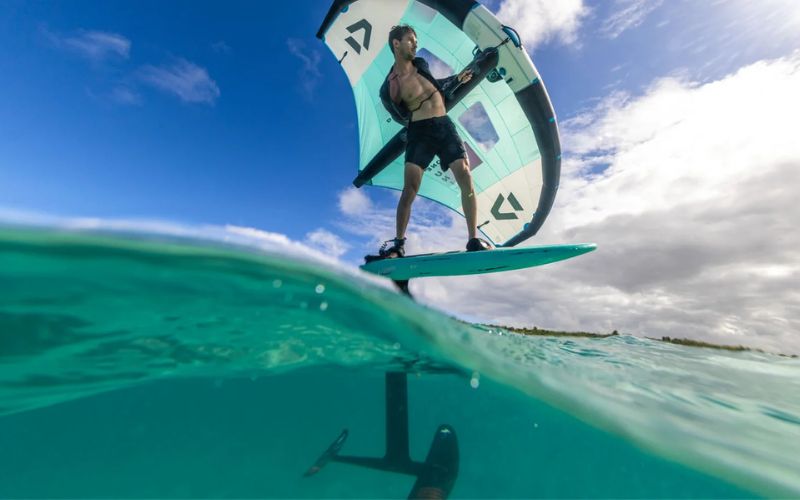
FOIL SIZES - SURFACE AREA:
Is there a right size foil?
In terms of foil area the simple answer is no, there is no magic number or shape that will work for any one riders weight or ability.
Most people start on something around 1600 – 2000cm² (2400cm² in some cases) depending on their size/weight and the conditions they will predominately being going out in. These sort of size foils are great for getting going and learning to wingfoil and for those looking to get going in really light winds.
If we then jump to the pros of this world who are using foils as small as 500cm² and up, we start to see a range of sizes being used. Realistically unless you are Kai Lenny, Laird Hamilton or Titouan Galea these tiny foils are probably never going to be in your quiver. They are designed to go fast and will be super twitchy but enable the real high speeds needed to ride huge waves and boost massive jumps. Some of the top riders have been riding foils before they were a product you or I could buy and some of the younger rider’s weight may be quite a lot lower than your average non-professional freerider. The sub 700 cm² foils are not everyday foils for any level of rider, they are the foils for when the conditions are more on the extreme side.
If beginners are starting on the larger foils and the high-end pros are riding the smallest foils it may seem that and intermediate foil could sit in the middle of that range. Which sits about right if you consider conditions too.
Currenlty there isn’t much choice when looking at foils of 700cm² and smaller so if we take our range from 2000cm² down to 700cm² that gives us some foils that are usable for mere mortals with a middle size of 1350cm².
This 1350cm² is a great all round size for intermediate and advanced riders and will give them scope to do a bit of everything. You should take weight, ability and the conditions into account.
From what we have been selling and what we see at the local beaches and from a very informal poll on the local foiling Whatsapp group this 1350cm² seems about right and some of the intermediate to advanced riders are using down to about 900cm² on the bigger/windier days on a regular basis. Any smaller foils than that only really seem to come out when the waves are big, or wind is really strong, and they are in much smaller numbers of participants and much less frequently.

ASPECT RATIO:
Again, there is no definitive number that is right when it comes to Aspect Ratio (AR) but understanding the pros and cons of each AR is key to understanding a foil as it directly effects your riding. The range of AR is also worth considering as brands versions of AR vary – a high aspect foil from one brand may only be a mid-aspect from another brand and this has changed as foils have evolved.

Many of the first foils on the market had an AR of around 3 and this may have been what you learnt to foil on. Some of the highest aspect foils in production right now have an AR of around 10. There may be a limit but who knows if foils are their yet?
In general, a higher aspect foil will be twitchier in pitch control (up and down) and will also have a higher take off and stall speed when compared to a lower aspect foil of a similar surface area. They will glide a longer distance as they are more efficient and will often have a higher speed. Hard to compare this but if you do try to compare different aspect ratios you will need a foils of a similar surface area.
Some of the foils that were considered high aspect a year or two ago are now not actually that high aspect when compared to some of the newer releases. There were also lots of people entering the foiling world (especially wingfoiling) and being advised to go on something high aspect to start with, as they wouldn’t outgrow it and what a lot of the people who took this advice ended up on is now considered a mid-aspect foil and is a great idea for some learning who wants a bit more of a challenge to start with as they will have something they may not out grow.

For learning a slow to take off and stable foil will always be easier than something quick and twitchy and this lends itself to the lower aspect foils as they are easier to control and more predictable.
The low aspect foil may not meet your higher level/more experienced expectations when it comes to speed and glide, and this is often why people want something higher aspect. Some people may find the mid aspect foil is the ideal foil as they have good speed, glide and once they get comfortable with the slightly twitchier pitch control the extra width of the foil makes them quite stable in rolling (banking the board). The extra speed, glide and stability in roll will help learn skills such as gybing and tacking. The foils will also be easier to pump (maintain momentum using your own weight).
With high aspect foils you can expect even more glide and more speed. These foils do tend to be pitched at the higher performance riders as they are less forgiving and will often require a change in setup to stabilizer and fuselage to maximize the performance. Luckily they brands are not saying if you buy this foil you need this size fuselage with this exact stabilizer, It’s all interchangeable within the brands foils so you can tweak and customize to get the feel you want.
Depending on the riding you are doing you may find the higher aspects foils don’t necessarily do you want straight out of the box. The width of the larger higher aspect foils does inhibit their turn radius and turn speed. For instance a foil of 1000cm² with an aspect ratio of 9 is going to be around about a meter wide or more and because of this width it can be hard to roll one turn into another. This is where you can tweak your foil with small fuselages and stabilizers to improve turn shape and make the foil feel livelier.
The other thing that will effect turn shape that is out of the buyers control is the chord at the wing tips. The deeper the foil is from leading edge to trailing edge at the wings tips the slower the foil will roll. In saying that most users will be glad to see this as having a small chord at the tips does make the foil a lot sharper.

Aspect ratio's in the image above are the average for the brands given range.
Anhhedral:
Most front wings are fairly flat or anhedral in design. This means if you look at the wing squarely from the front the wings will either be in line with the middle of the wing or slightly lower. A flatter wing is more efficent in a straight line as most of the lift will be going directly up but with some anhedral shape to the foil you gain a much better roll meaning easier entry and exit into and out of a turn.
Towards the wing tips of any foil is where you will find the most turbulance and there are many designs to try and limit this. So some foils will have much squarer wing tips and some will point up or down to try and limit this turbulance. On most commercial planes you will notice the wing tips point up and this is for the exact same reason. More often than not with hydrofoils the wing tips will point down as it is less terrifying to fall in on.
Chord & Thickness:
The Chord of a foil is very often over looked but as mentioned above it has an impact on foil control and their are varying chord lengths is a feature acorss every foil range.
Chord is really hard to measure accurately (especially at home) as foils tend to taper in towards the wing tips so the given chord on a foil is the average chord measured across the wing.
You will notice most foils taper in towards the wing tips as this improves the roll of a foil making the turn sharper.
The thinner a chord the more lively the pitch control of a foil and vice versa the larger chord will give more stable and predictable pitch control.
The thickness of a foil has a big effect on the amount of lift generated but also the amount of drag created as well as huge impact on the strentgh of a foil.
The thinner a foil the less drag it will have but the less lift it will create especially at low speeds. Vica versa a thicker foil will create more lift but have more drag. If you compared two foils of the same size in surface area then a the thinner foil would need more power/forward speed to get going but have a greater top speed whilst the thicker foil would get going with less effort but have a lower top speed.
WHAT FOILS ARE RIGHT FOR YOU.
There are several things that make a foil good when it comes to shape. The usual consideration is size and aspect ratio but the thickness and chord also have an impact as well as the anhedral or dihedral shapes. With an understanding of the shape of the foil you will be able to then decide which foil suit your intended riding style.
But the best way to look at the different foils shapes is to look at the styles of riding and why things might be good for that style.
SPEED/RACING
Speed is always going to be an obsession for some and what makes a foil fast firstly is less drag. Smaller foils will always be faster as they have less resistance. The second biggest thing with speed is control. With a twitchy foil you will find it hard to keep pushing to the highest speeds. These two aspects of a foil don’t necessarily go hand in hand – the smaller the foil the twitchier it is and the more power it needs to get going.
So to go fast you need to use the smallest foil you can get going and keep going on. Most small fast foils tend to be thin and the foils tend to be mid/high aspect. The slim design reduces drag and the high aspect design helps with roll stability, the thickness of a foil is not usually advertised. You can then increase or decrease pitch and yaw stability with fuselage length and stabilizer size/shape.
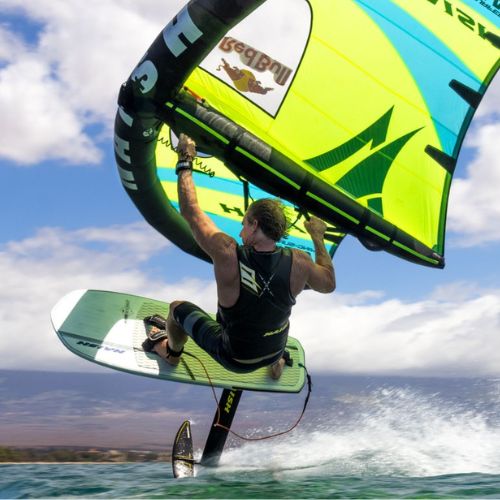
WAVES
Part of the appeal of foiling the ability to get huge amounts of fun from tiny waves that were almost inaccessible to anything with a fin, but as with every other sport in waves the search for bigger faster waves is always on for some. While all foils will work in waves, different size/shapes will work in different ways depending on the conditions.
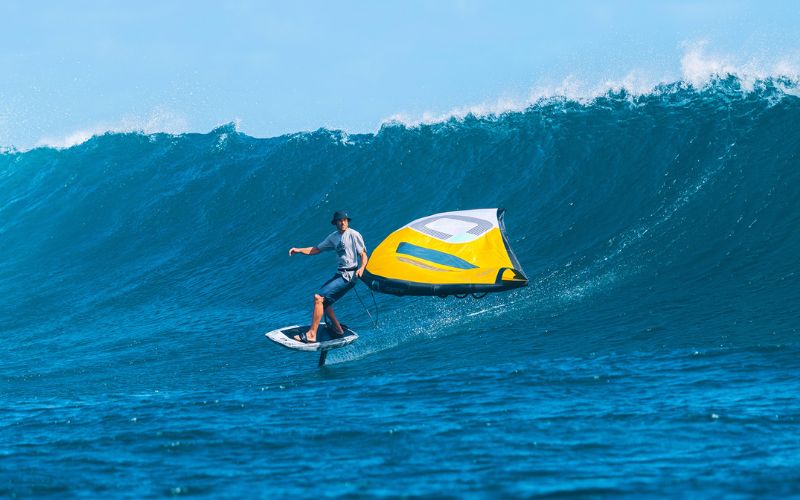
Small waves (waist high and under) – These conditions are part of the appeal of foiling. If you are competent on a foil you can enjoy the extended glide a small wave gives and most foils will work in these conditions. The bigger foils will work really well in the smallest waves. If you have a smaller foil you may find you shoot out of the front of the wave as your foil is quicker than the wave. To keep the foil in the wave you will need to turn along the wave and go down the line or turn up and down the wave face.
Medium Wave (waist to head high) – The bigger the waves the faster they move and therefore you may find your biggest foil becomes a bit of a handful and that you keep breaching (foil pops out of the water) As the foil accelerates it creates more lift if you can’t control this lift you will breach. One option is to slide the foil back in the track, you will sacrifice a little light wind and slow speed ability but gain pitch control at higher speeds. Step down in foil size and you will travel faster and it will be easier to stay in control on the wave. The smaller you go the more you may need to turn to stay on the wave.
Big Waves (Head high and over) – For most riders this may seem like an intimidating thing to do and in most places even getting off the beach when its this big is challenging. But the same rules apply, big waves need small foils as they are fast.
Speed and turning are the key ingredients to wave riding and the turn shape is a personal choice depending on your riding style and the wave shape. The wider the wing span of a foil the harder it will be to turn tightly so if you shoot out the front of a wave on a wide foil then start to carve back around towards the you may find the wave has caught you up before you can turn back towards the beach. Quite an extreme example but you may not be able to get the tight, snappy small turn on a small wave you want. In this situation a narrower foil will carve those tight turns shapes much easier. So, a medium or low aspect foil may allow a tighter turn.
Turn shape is what most of the tuning is about for wave riders. Changing the fuselage length and stabilizer size/shape are two of the easiest ways to change turn shape but as you keep going down the foil sizes you not only gain speed but you will also gain more maneuverability. Compare the largest high aspect foil in a range to the smallest and the chord and wingspan will be very different making the smaller foils easier to roll through the water.
DOWNWINDING
The ability to glide in wind blown swell is another huge appeal of winging. People are organizing massive downwind sessions with organized transport, and this is something that hasn’t really appealed to any other water sport I the same way. On the smaller side of things, the efficiency of a foil has made going upwind a few miles to enjoy a couple of miles of down wind joy is also completely feasible.
Much like with riding in waves there will be different styles of riding and different conditions that suit different foils, but the key is efficiency and speed. Whilst down wind paddleboarding it is key to have the right foil for the swell with a wing in your hand it doesn’t matter as much as you can also use the wing to keep you going.
As swells travel at different speeds it can be hard to match the foil and swell speeds every time you go out but the key ingredient is efficiency so downwinding lends itself nicely to higher aspect foils. As you are continually going with the with swell you tend to get less opportunities for tight turns so again a wide foil is not really an issue. Bigger high aspect foils will catch and ride smaller slower swells for longer. If we use a bigger foil in bigger faster swells, you may find the foil leaves you behind after your initial acceleration meaning you will have to ride the next lump. With a smaller faster foil, you may find it hard to get on the smallest of wind-blown swells but as the swell increases in size you will glide on it and be able to turn along it and look for the next lump to glide onto.
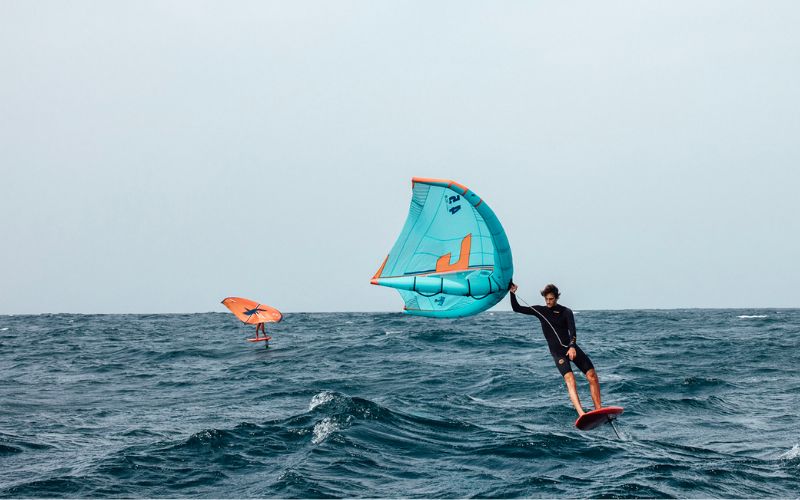
TOP TIP: If you are committing to a long down winder its worth going big on at least one bit of kit. If the wind does drop off when you are on a small board with a small foil and small wing are you going to be able to get going again?
FREESTYLE
Whilst technical freestyle will never be the choice of everyone, the level of freestyle continues to push the boundaries of the sport. Part of the joy of freestyle is that it can be whatever you want it to be – carving 360’s, aerial 360’s 720’s or more, riding backwinded, flips or your first jump. Whatever you are doing its going to improve your foil and wing control. So essentially it doesn’t matter what kit you’re using as you will be able to give some aspects of freestyle a go.
If you want to get into freestyle and do some of the bigger aerial tricks then speed is the key. In order to get the height, you need to go fast so a smaller foil is ideal. You may want to steer away from the highest aspect foils especially in their bigger sizes for aerial freestyle as you can trip over the wing tips as you come into land.
Some freestyle events are done in waves with wave riding scoring points so the ability to turn tight is essential and so a medium aspect foil is often the foil of choice at these events.
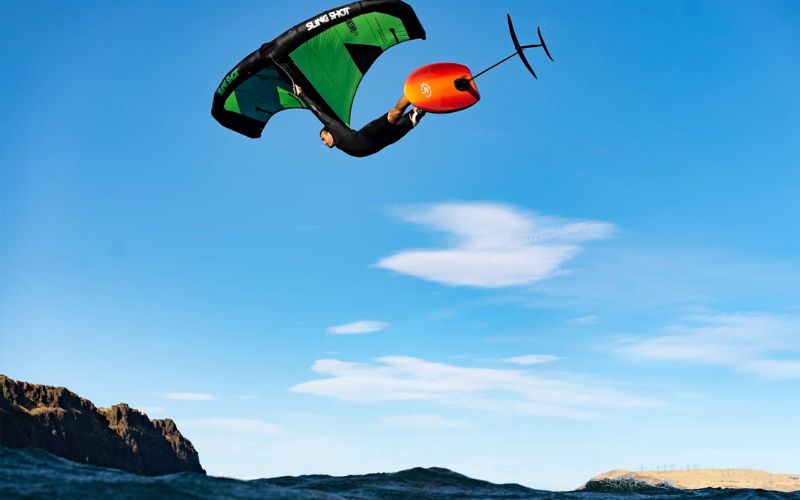
OVERVIEW
With different shapes of foil working for different aspects of the sports there is no one size foil that will suit everyone. Your size/weight and how you like to ride will mean there is a right foil for you but you may also find that you find the limits of that foil in some conditions and as you progress.
People are building quivers of foil parts (fuselages, stabilizers and shims) so they can tweak and tune to get a different feel in different conditions and there have been people cutting and sanding wing tips to get exactly what they want. At the other end of the spectrum there are people with the one foil for all conditions.
No right or wrong either way but with different foil setups getting different amounts of performance in different conditions it is worth thinking about what you want to achieve with the foil before diving into something too specific.
Make sure you check out all our foiling parts from all the major brands here.
Content created by King of Watersports KOW Copyright
